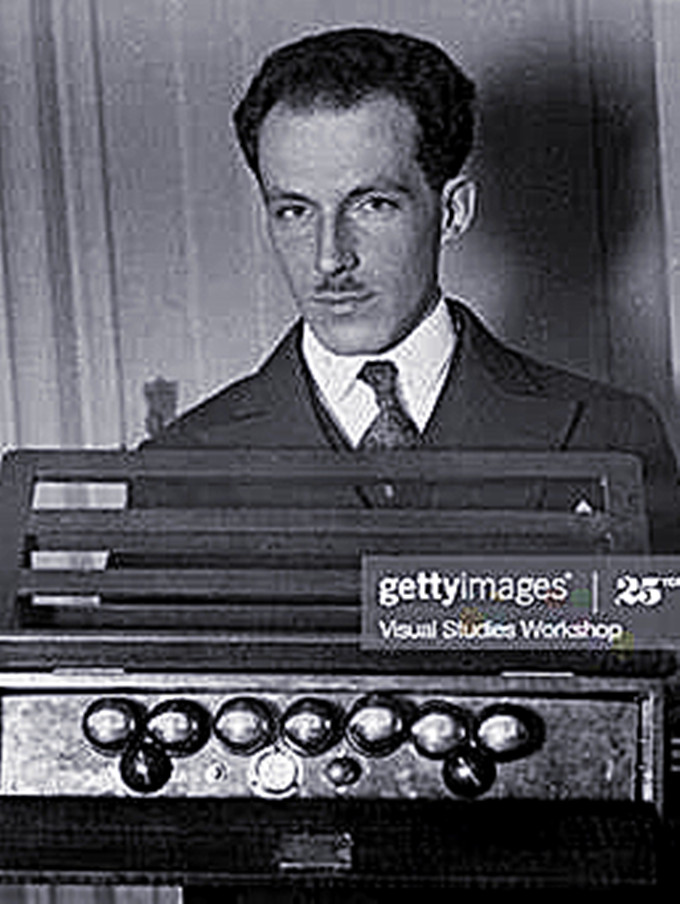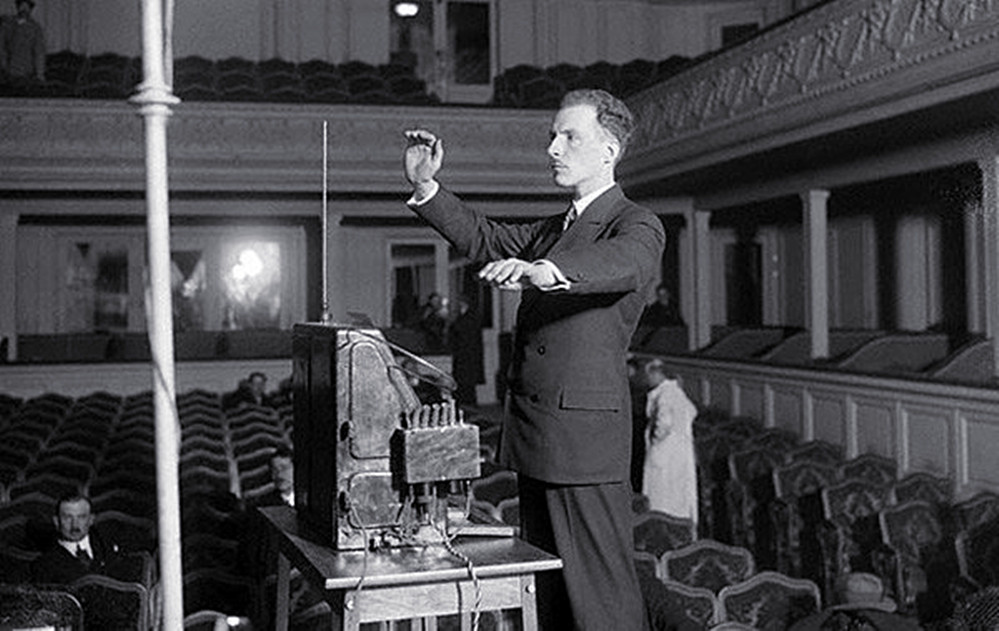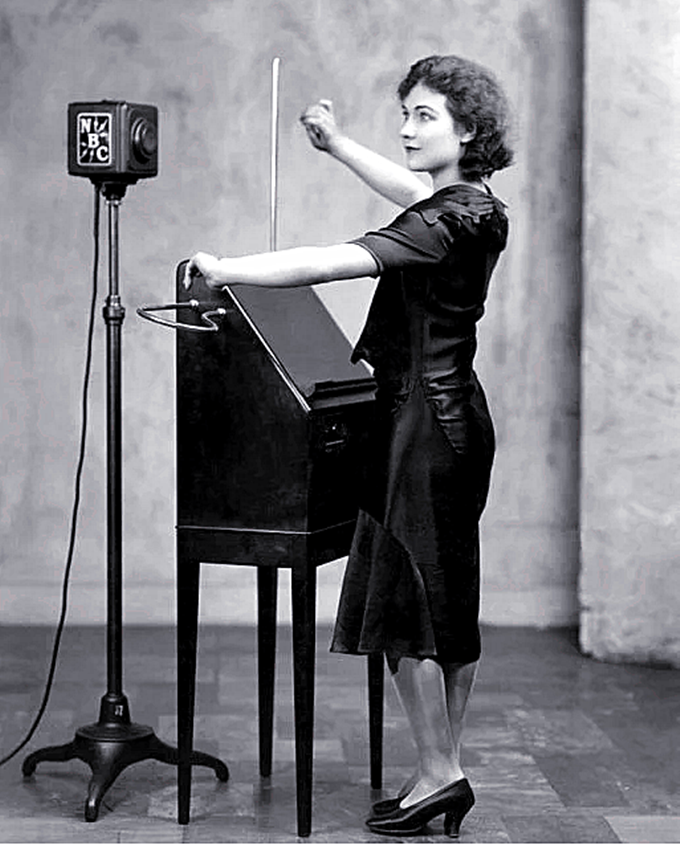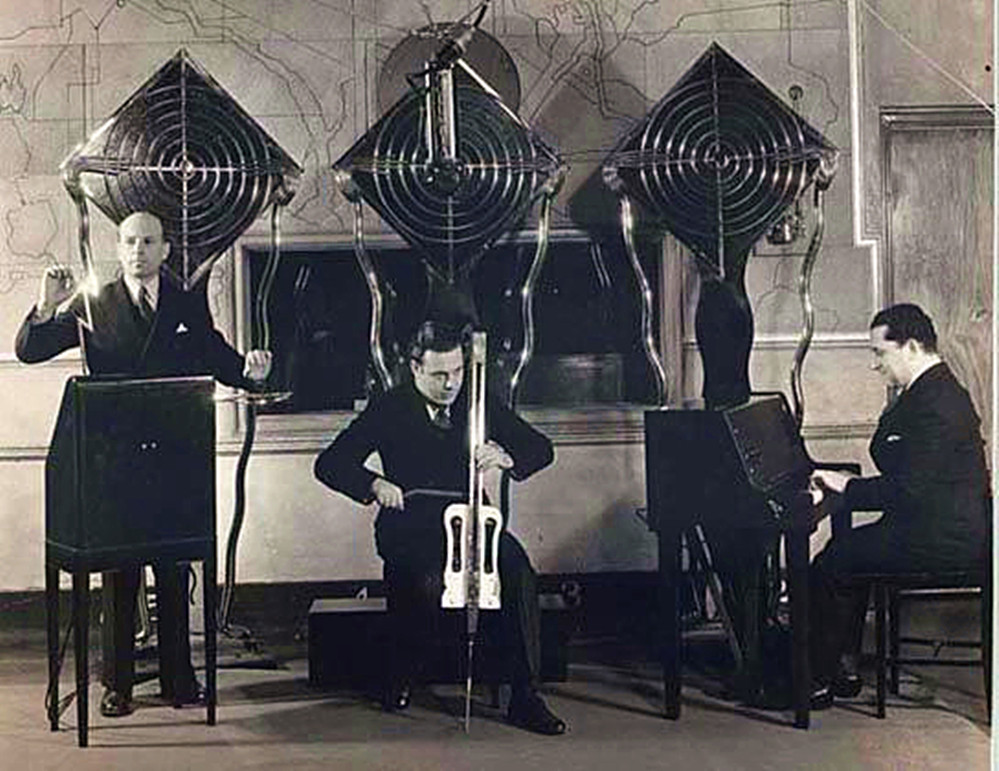| |
| |
 |
|
| |
田润德
编译
文/图 2020-08-05 19:36 |
|
| |
|
|
|
|
| |
 |
|
|
|
| |
莱昂.特里明(Leon
Theremin,1896——1993) |
|
|
|
| |
|
|
|
|
| |
维克多.特里明或莱昂.特里明演奏20世纪20年代的歌曲莱昂.特里明发明
|
|
|
|
| |
Victor Theremin or RCA
Theremin plays 1920s song Leon Theremin invention |
|
|
|
| |
|
|
|
|
| |
音乐历史上的今天
1920年8月5日,有创新精神的大提琴家莱昂.特里明(Leon
Theremin,1896——1993)在莫斯科技术学院展示他的特里明电琴(Thereminovox)的时候,电子音乐便来到了人间。
在二十世纪的头几十年里,无线电工程师偶然发现了拍频或外差振荡器的原理。
外差效应是由两个频率相似但变化的高频声波组合并产生较低的可听到频率,等于两个射频之间的差异(约20赫兹至20000赫兹)。
他们是莫里斯·马丁诺特、尼可莱·奥布霍夫、阿曼德·格莱特和俄罗斯Cellist和电子工程师莱昂.特里明(Leon
Theremin)在内的几位工程师和设计师注意到了这种效果的音乐潜力。
拍频或外差振荡器的原理是在二十世纪前几十年由无线电工程师尝试无线电真空管而偶然发现的。
通过相似但变化频率的两个高频射频声波产生并产生较低的可听频率来产生外差效应,等于两个射频之间的差(大约20 Hz至20,000 Hz)。
包括Maurice Martenot,Nikolay Obukhov,Armand Givelet以及俄罗斯大提琴家和电子工程师Leon(or
Lev)Sergeivitch Termen在内的数名工程师和设计师都注意到了这种效果的音乐潜力。
利用外差效应的一个问题(外差效应是两个高频信号相加而产生的可听音,这是两个高频之差。这种效果是许多基于真空管的电子仪器的基础。”)
音乐目的是,当人体靠近真空管时,人体的电容会引起频率变化。
莱昂·特里明意识到,身体电容可以用作一种乐器的控制装置,而不是问题,并最终使演奏者摆脱键盘和固定的语调。
Termen于1917年在苏联制造的第一台机器被命名为“ Theremin”(继他本人之后)或“ Aetherophone”(来自“
ether”的声音),并且是第一个利用外差原理的工具。
最初的Theremin使用脚踏板控制音量,并使用开关机构改变音高。该原型机在1920年演变为量产模型Theremin,这是一个独特的设计,类似于4腿上的留声机机壳,带有突出的金属天线和金属环。乐器的演奏是通过将双手在金属环上移动以提高音量,在天线上移动以进行音高。输出是由表演者调制的单声道连续音。乐器的音色是固定的,类似于小提琴弦的声音。声音是由两个射频振荡器的外差组合直接产生的:一个以170,000
Hz的固定频率工作,另一个以168,000到170,000
Hz的可变频率工作。第二个振荡器的频率取决于音乐家的手与音高天线的接近程度。固定和可变射频的差异会导致0至2,000
Hz之间的可闻拍频。声音来自振荡器,后来的型号增加了放大器和大型三角扬声器。该Theremin模型于1920年在莫斯科工业博览会上首次向公众展示,并由列宁见证,列宁要求在乐器上上课。列宁后来委托了600种特雷明模型在苏联各地建造和巡回演出。
Termen于1927年离开苏联前往美国,并于1928年获得Theremin的专利。Theremin在1930年代由RCA在美国销售和分销,为DIY套件形式或制成的乐器(后来的爱好者)其中的工具包括罗伯特·穆格(Robert
Moog),他在1950年代制造和销售晶体管的Theremins。在1960年代晶体管问世之前,外差式真空管振荡器已成为产生电子声音的标准方法,并被该时期的电子乐器设计广泛使用。
今日视频:1、纪录片《莱昂.特里明发明-莱昂.特里明演奏20世纪20年代的歌曲》;2、
特雷门琴女王与大提琴梦幻演奏惊艳小桌音乐会。 |
|
|
|
| |
 |
|
| |
莱昂.特里明琴的创造者,用这种乐器演奏。 |
|
|
|
| |
Lev Theremin, creator
of the Theremin, performing with the instrument. |
|
|
|
| |
它吸引了许多音乐爱好者的想像力。
它的外观与之前的任何事物都非常不同。
Stuff的工作方式将RCA的1930年代版本描述为“更像是一个小的写字台,而不是电子书的未来。”
如今,人们对特里明的超凡脱俗的魅力表示赞赏。 音乐家多里特·克莱斯勒(Dorit
Chrysler)今年被史密森尼杂志(Smithsonian Magazine)引用,称其具有“胡迪尼效应”。
因为它似乎违反了物理定律。”
她接着说:“它真的像声音一样传递任何一种情感状态-如果您的声音颤抖,焦虑,生气或快乐,它就会发出声音。 它们是不同的颜色。”
莱昂.特里明的成功并不能维持成功。 大萧条(使他的发明过于昂贵),个人财务困难和纳粹主义的兴起使他在30年代后期回到苏联。 |
|
|
|
| |
It
captured many music lover’s imaginations. The look of it was so
different to anything that had come before. How Stuff Works
describes RCA’s 1930s version as “more like a tiny writing desk
than the future of electronica.” The otherworldly charm of a
theremin is appreciated today. Quoted by Smithsonian Magazine
this year, musician Dorit Chrysler refers to it having “the
Houdini effect. Because it seems to defy the laws of physics.”
She goes on to say, “It really transmits any kind of emotional
state just as the voice does—if your voice is trembling, if
you’re anxious, if you’re angry, or happy. They’re different
colors.”
Success didn’t sustain for Lev Theremin. A combination of the
Great Depression (which rendered his invention too expensive),
personal financial difficulties and the rise of Nazism saw him
go back to the Soviet Union in the late Thirties. |
|
|
|
| |
 |
|
|
|
| |
特雷门琴在美国被称为家庭“新奇的乐器”,并在1940-50年代的许多电影原声中出现,它也出现在几张1960年代的流行唱片中,但从未克服它的新奇的吸引力;用于效果而不是作为一种“严肃的乐器”,大多数录音使用特雷门琴作为弦乐器的替代品,而不是利用乐器的微音调和音调特征。列昂·瑟吉维奇·特曼在原有的特雷门琴的基础上进行了改进,包括“Terpsitone”、“Rhythmicon”、“键盘特雷门琴”和“电子大提琴”。 |
|
|
|
| |
The
Theremin became known in the USA as a home ‘novelty instrument’
and featured in many film soundtracks of the 1940-50’s, it also
appeared in several pop records of the 1960’s but never overcame
it’s novelty appeal; used for effect rather than as a ‘serious
instrument’, most recordings employ the Theremin as a substitute
string instrument rather than exploiting the microtonal and
pitch characteristics of the instrument. Leon Sergeivitch Termen
went on to develop variations on the original Theremin which
included the “Terpsitone“, The “Rhythmicon“, the “keyboard
Theremin” and the “Electronic Cello”. |
|
|
|
| |
|
|
|
|
| |
Today in
the history of music
Electronic music came to life on August 5, 1920, when the
innovative cellist Leon Theremin (1896 -- 1993) displayed his
Thereminovox at the Moscow Technical Institute.
In the early decades of the twentieth century, radio engineers
stumbled upon the principle of beat frequency, or heterodyne,
oscillators.Heterodyne effects are a combination of two
high-frequency sound waves of similar but varying frequencies
and produce a lower audible frequency, equal to the difference
between the two radio frequencies (approximately 20 hz to 20,000
Hz).They were several engineers and designers, including Maurice
Martinot, Nicolai Obhov, Armand Gretel, and Russian Cellist and
electrical engineer Leon Theremin, who noticed the musical
potential of the effect.
The principle of beat frequency or heterodyne oscillator was
discovered by accident in the early decades of the twentieth
century by radio engineers experimenting with radio vacuum
tubes.Heterodyne effect is produced by producing two
high-frequency radio frequency sound waves of similar but
varying frequencies and producing a lower audible frequency,
equal to the difference between the two radio frequencies
(approximately 20 Hz to 20,000 Hz).Several engineers and
designers, including Maurice Martenot, Nikolay Obukhov and
Armand Givelet, as well as Russian cellist and electronics
engineer Leon (or Lev) Sergeivitch Termen, have noticed the
musical potential of this effect.
One problem with using heterodyne effects (heterodyne effects
are audible sounds produced by the addition of two high
frequency signals, which is the difference between the two high
frequencies.This effect is the basis of many electronic
instruments based on vacuum tubes."The purpose of the music was
that the capacitance of the body would cause a change in
frequency as the body approached the vacuum tube.
Leon Tremin realized that body capacitors could be used as a
control device for an instrument, rather than a problem, and
would eventually free players from keyboards and fixed
intonation.Termen's first machine, built in the Soviet Union in
1917, was named "Theremin" (after him) or "Aetherophone" (the
sound from "Ether"), and was the first tool to exploit the
heterodyne principle.
The original Theremin used pedals to control volume and a
switching mechanism to change pitch.The prototype evolved into
the mass production model Theremin in 1920, which was a unique
design similar to the phonograph case on four legs, with
protruding metal antennas and metal rings.The instrument is
played by moving the hands over a metal ring to raise the volume
and over an antenna to raise the pitch.The output is a mono -
tone continuum modulated by the performer.The timbre of the
instrument is fixed, similar to the sound of a violin
string.Sound is produced directly by a heterodyne combination of
two rf oscillators: one operating at a fixed frequency of
170,000 Hz, and the other at a variable frequency of 168,000 to
170,000 Hz.The frequency of the second oscillator depends on how
close the musician's hand is to the pitch antenna.The difference
between fixed and variable rf frequencies results in audible
beats between 0 and 2,000 Hz.The sound came from an oscillator,
and later models added amplifiers and large triangular
speakers.The Theremin model was first shown to the public at the
Moscow Industry Fair in 1920 and witnessed by Lenin, who
demanded lessons on Musical Instruments.Lenin later commissioned
600 Terming models to be built and toured throughout the Soviet
Union.
Termen left the Soviet Union for the United States in 1927 and
received a patent for Theremin in 1928.Theremin was sold and
distributed in the United States by RCA in the 1930s, for
instruments in the form of DIY kits or made (later fans) that
included Robert Moog, who built and sold transistors called
Theremins in the 1950s.Heterodyne vacuum tube oscillators became
the standard method for generating electronic sound before the
transistor was invented in the 1960s and were widely used in the
design of electronic instruments during this period.
Video of the day: 1. Documentary "Invented by Leon Treming -
Leon Treming Plays songs of the 1920s"; 2. Amazing
Little table concert with Theremin Queen and Cello Dream.
|
|
|
|
| |
 |
|
|
|
| |
亚历山德拉·斯蒂帕诺夫在NBC电台播放Theremin,1930年 |
|
|
|
| |
Alexandra Stepanoff
playing the theremin on NBC Radio, 1930 |
|
|
|
| |
 |
|
| |
用特里明琴演奏的乐队(Theremin
)在全神贯注进行中。 |
|
|
|
| |
绝大多数国人听说合成器,知道它和电子琴的大概区别得益于雅尔访华。一九八一年十月,电音大师让·米歇尔·雅尔在北京、上海两地演了五场“激光电音秀”。开演前后,国内媒体炮制了大量扫盲教材,譬如《北京晚报》在当月十九日的第三版发文《电子音响合成器》。特别打上“应读者要求”的图标,标题旁边还加粗注明:“法国音乐家即将为首都观众演奏电子音响合成器。一些读者在看到举办这种音乐会的消息时,都希望知道什么是电子音响合成器。”可怜的读者,这篇科普利器从正文的第一句就错了:“传统的管弦乐器和电子琴、电吉他等电子乐器都是已为大家熟知的乐器。”作者错把电吉他归入了电子乐器的大家庭。电吉他虽然通电,但发音全靠琴弦,而电子乐器的发声体是电子振荡器。这在维基百科里都讲得很明晰,还有对电子音乐的定义:“使用电子乐器以及电子音乐技术来制作的音乐。”
一个非常广博的概念,由此出发,其实电子音乐的世界远比摇滚、爵士、古典这些音乐类型的疆土要广阔,而且,相信在数码主导的未来,多数音乐都是电子音乐。
显然,电子乐器的历史要比电子音乐来得久远。换言之,研究中国电音的发端,首先在于钩沉中国的第一台电子乐器。我悬揣它应该是被引进的,就像留声机,作为西洋的奇技淫巧,先是舶来品,被中国接受之后才有国产的必要。“老大哥”苏联总是领先一步,他们研发电子乐器甚至早在苏联建国之前。一九一九年,俄罗斯人莱昂·特雷门(Léon
Theremin)发明的特雷门琴是世界上最早的电子乐器之一,这玩意甚至不用弹,演奏起来双手悬空,各种动作让人想起乐团的指挥。遗憾的是,现有文献没能留下电子乐器“舶来”中国的痕迹。 |
|
|
|
| |
 |
|
| |
卡耐基大厅的泰明管弦乐队。 c1930 |
|
|
|
| |
Theremin Orchestra,
Carnegie Hall. C1930 |
|
|
|
| |
|
|
|
|
| |
|
|
|
|
| |
特雷门琴女王与大提琴梦幻演奏惊艳小桌音乐会! |
|
|
|
| |
2019年1月11日| Tom Huizenga -
你如何演奏一种你从未接触过的乐器?请观看Carolina
Eyck(卡罗莱娜.艾克)的表演,她是第一个把特雷门琴带到Tiny
Desk(小桌音乐会)的人。这种具有滑溜溜般音色的早期电子乐器大约在100年前由苏联科学家Leon
Theremin(里昂.特雷门)教授发明,他是一位喜欢间谍活动的苏联科学家。特雷门琴看起来像一个简单的黑色金属盒子,带有几个突出的触角,但是要像Eyck(艾克)那样能够通过精确指法操控并让它发出感情丰富、清晰地声音来,这是需要一种特殊且精湛地技艺的。
这次Carolina
Eyck(卡罗莱娜.艾克)在演奏特雷门琴的基础上使用了looping功能,让特雷门琴的表现更加立体和有层次感让音乐整体更具有魅力。Carolina
Eyck(卡罗莱娜.艾克)告诉Tiny
Desk的观众:“我真的是在玩空气,我敢保证玩的时候没碰到任何东西。”其实她是通过手的位置影响电磁场,以产生音高和音量。
Eyck(艾克)被认为是当今最杰出的女性特雷门琴专家之一,她自己创作了自己的作品,比如打开乐器的脉冲“Delphic”,并且她有大牌作曲家为她写特雷门琴的唱片协奏曲。加入Eyck的还有大提琴演奏家Clarice
Jensen(克拉丽斯·延森)。两位音乐家以曲目《Frequencies》(频率)结束,这是一部专门为这个Tiny
Desk表演而创作的作品。视频中的3首作品的名称为:
1、"Delphic"(神谕)
2、"Three Leos"(三只狮子)
3、"Frequencies"(频率)
【贴士】:德国出生的音乐家和作曲家Carolina
Eyck(卡罗莱娜.艾克)是世界上最著名的特雷门音乐大师之一。
特雷门琴(Theremin),是世界第一件电子乐器, 生产於1928年,由前苏联科学家 Leon
Theremin
(里昂.特雷门)教授发明,同年由一位女演奏家作公开演奏,连爱因斯坦都曾参观,至今依然是世上唯一不需要身体接触的电子乐器。其后,Theremin被广泛应用于40至50年代好莱坞电影配乐中;接着Beach
Boys
(海滩男孩)乐队在60年代采用于其流行曲中,使其更加大放异彩。Theremin的原理是利用天线和演奏者的手构成电容器,天线接在一个带有放大电路和扬声器的LC回路上,通过天线接受手的位置变化来发出声响。
Theremin是最先以发明者的名字(Leon
Theremin,里昂.特雷门)来命名的电子乐器,它的声音是由两个(固定/可变)震荡器之间的频率差所产生的,表演者透过双手来控制可变震荡器的天线移动使之发声。而在火热的美剧《生活大爆炸》(The
Big Bang Theory)中,活宝Sheldon也曾演奏过这一神奇的乐器。 |
|
|
|
| |
2011
鲁宾斯坦国际钢琴比赛
以色列本国作曲家P.
Ben-Haim的五首钢琴小品,应该是鲁赛要求的必弹曲目。这孩子为了比赛弹过Shchedrin,甚至还弹过Chick
Corea……不容易啊。 |
|
|
|
| |
|
|
|
|
| |
未得原作者编者授权严禁转载www.mt77.com任何内容 |
|
|
|
.png)

